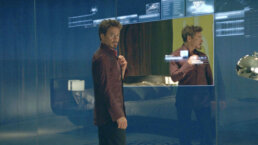“Vision videos”. They can be the key to opening up the minds of decision makers to green light game changing products and technologies. They can inspire, plot the path forward and provoke thought across corporate leadership to help drive groundbreaking initiatives. Executed well, and they can truly become the blueprint for a company’s destiny. So when did crafting these videos become as commoditized as the daily price of steel? Lately, I’ve been observing a very depressing and disappointing trend. I have been sadly witnessing an ever increasing number of online services that will gladly craft your corporate/sales/vision video for a bargain basement fixed price, based upon a tiered menu of pre-set options. The dies are cast, all you have to do is select the mold you want, and they’ll stamp your video right out in record time. Just like buying a car and deciding if you want to add in a sunroof, nav or driver assist package at the factory. It would seem there is no longer an appreciation to the true value of an idea, a well thought out concept, and the skilled execution necessary to effectively bring that idea to life. It’s like comparing a painter’s creation of an original piece of art to a paint-by-numbers set. At its most extreme, I’ve started to see automated services that will generate ‘custom’ news videos, in near real-time speeds. Using mathematical procedures and algorithms, a canned library of graphics and transitional effects, the service will generate a script, search the internet for imagery and stock footage, and splice it all together with music and a vo. Voila! instant video.
A successful video must start first with a brilliant concept. Writers, designers, and artists must brainstorm to find that elusive winning idea that a story can then be built upon. It all boils down to telling a great story—a compelling and convincing story. Once that solid foundation has been carefully articulated and considered, the design and filmmaking artistry can begin. Frequently, a vision video’s intent is to show a future product that hasn’t been built yet being used in a real world scenario in the most believable and authentic way. Indeed these videos can function as fully realized prototypes. To achieve this goal, a well planned live action shoot is essential. This could involve filming on location or on a stage—complete with casting, props, on-set art direction and visual effects supervision.
Depending on the complexity, depth and sophistication of the story and vision, this can easily scale into a mini feature film production to do it right. After the footage has been skillfully shot, the responsibility rests on the effects and animation artists to spend the remaining production schedule assembling all the pieces—real and designed—seamlessly into one visionary film that no one would think is a simulation (think Tony Stark using a fully functional glass smart phone that doesn’t really exist).
A well known, basic, (albeit over-simplified) sales strategy is to give a potential customer an emotional reason to buy now (ERBN). At their essence, these videos have always been a sales tool—whether it’s selling an idea through to corporate leadership, selling a concept to a potential investor or selling a product to an end user. If these videos fail in any way to elicit an emotional response, then the entire endeavor was completely wasted and futile. An effective video is one that has been created at the highest cinematic level. I consider a true cinematic experience to be one that gives the audience a delightful escape; having the power to move them toward another emotional state. I’ve been running a successful design studio for 15 years that specializes in telling stories that move people’s emotions. We’re storytellers at our core. If you cant tell a compelling story, then any amount of filters, effects and lens flares won’t make a bit of difference. So much of our work involves visualizing a future of possibilities, evoking an emotional response of the audience—an audience usually made up of corporate stakeholders and investors. Our job is to craft the most compelling story, the most believable scenarios, to open up the imaginations of the audience, inspire the viewer, and show them the art of the possible. Our job is to keep them on the edge of their seats and move their emotions. I’ve been in video presentations where an audience is left speechless and teary eyed; where these videos become the catalysts of change. These are prime moments and opportunities for ‘thought leadership’ to make a difference on a grand scale.
I’m not writing this as a cry of sour grapes for any missed opportunities and this is not an attempt to sell my company’s services as a video design studio. I’m deeply concerned at the cheapening of an art form and a devaluation of craft that has been reduced to formulaic cartoons done at absurd prices. These videos can also be condescending, juvenile and about as 2 dimensional as the animation that they’re built upon. They can also be incredibly boring and put the audience right to sleep. Of course, there’s certainly a time and place for “info-graphics style” explainer/instructional videos—especially when trying to take a complex concept and make as simple, clean and clear as possible. But even in these instances, a high level of design sophistication and skill always needs to be accounted for. And when the goal of a video is to inspire an audience about future possibilities for a product or to open the minds of a skeptical decision maker to greenlight a future initiative, then carefully crafting a story with the same vision as a dedicated filmmaker is the only approach. Buyer beware: the old adage you get what you pay for most certainly holds true here.
Jeremy Lasky
An entrepreneur and creative leader, Jeremy Lasky started his career at R/GA right after graduating from Carnegie Mellon University where he studied Graphic Design, Architecture and Business. For 5+ years he lead design efforts for feature films, global ad agencies and broadcast networks. In the Fall of 2001, Lasky co-founded Perception, a cutting edge motion graphics studio that lead the revolution in creating groundbreaking design and visual effects on the desktop. Now in it's 18th year, the studio has sharpened its focus to become global experts in designing futuristic UIs for both feature films and for the most powerful brands in technology. From Iron Man to IBM, from The Avengers to SpaceX, the studio has an extremely unique niche that truly bridges the gap between science fiction and science fact. Lasky leads new business strategies, shapes the company’s growth, while overseeing a full-time staff of 15.
Lasky has been a keynote speaker and presenter at: Promax 2016, Disney Art Summit, Disney Creative Loop Series, Science of Team Science Conference, Biogen Techology Innovation Symposium, TV of Tomorrow Conference, and Razorfish's Global Creative Summit. Lasky has lectured on design and guest speaker at OTIS, SCAD, Carnegie Mellon’s ETC and NYU ITP. He's also given presentations and workshops at some of the biggest tech giants in the world including Samsung, IBM, SpaceX, Intel, Microsoft, GE, Yahoo, Audi, Mercedes, Ford, Chrysler, Visa and Apple.
Lasky’s work has been featured in dozens of design and industry publications and he has garnered many of the most prestigious awards in the design world including AIGA, The Art Director’s Club, Broadcast Design Association/Promax, CLIO, International Andy Awards, Monitor Awards, New Media Invision Awards, One Show Awards, The Charleston International Film Festival Awards, Telly Awards, and The Type Directors Club.


